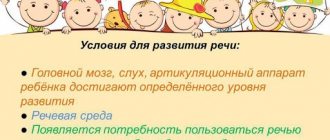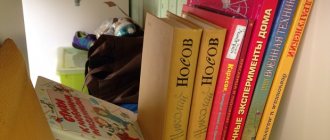Paintings with salt
Many of you have probably seen and admired amber paintings made by artists. A similar work of art can be made using regular coarse table salt.
While dinner is cooking on the stove, draw a winter landscape with your child on a piece of cardboard. Apply a thick layer of glue (preferably PVA) to the roofs of houses and tree branches with a brush and sprinkle salt on top. When the glue dries, any unadhered salt residue can be shaken off. Using this technique you can make a beach, a Barbie doll dress decorated with diamonds, and so on.
Timer
Almost every kitchen has a timer (or a microwave with a timer). Each time you set the time on the timer, announce out loud “1 minute,” “5 minutes,” etc. And when the timer beeps, remind your baby again how much time has passed.
Regular exercises with a timer develop a sense of time. In addition, the timer can be used as a “recess bell.”
For example, you are cooking, and your child asks you to read a book. Set a timer for a few minutes and explain to your child that you will be reading when the recess bell rings. Don't forget to keep your promise!
project “Introduction to the profession of a cook”
If the vegetable has been named correctly, the teacher leaves it on the table, and the child must say where the item should be placed - on a plate or in a vase. (If the child makes a mistake, the vegetable is put back into the bag.) Children examine the vegetable, determine its color and shape. “This is the wonderful carrot Nikita found,” says the teacher and clarifies, “what is it like?” (“Long and plump, orange,” - choral answer and 1-2 individual ones.)
Appendix No. 5
Lesson summary:
“Excursion to the kindergarten kitchen”
Purpose:
introduce children to the work of a cook, expand and consolidate knowledge about kitchen utensils.
Preliminary work:
instructing children about the rules of conduct in the kitchen.
Excursion progress:
Guys, today we will go on an excursion to the kitchen of our kindergarten, which is located on the first floor. Who can answer: what is “kitchen”? (answers)
A kitchen is a room where food is prepared. I would like to remind you once again that this is a place of increased danger, because there are hot stoves and hot food in the kitchen. Therefore, I ask you to be very careful: do not push each other, so as not to get burned on the stove or pan.
Come on in, guys, they're already waiting for us. Say hello. We are met by the main cook - Nadezhda Petrovna and her assistant Elena Petrovna
Nadezhda Petrovna, please show us your work
space.
Cook: Guys, this room is called the kitchen. Here we prepare delicious food for you every day. What did you have for breakfast today? (answers) We, the cooks, prepared the porridge. To do this, we came to kindergarten very early, when both you and your parents were still sleeping in their warm beds. I turned on the electric stove and placed a huge pan on it. Then she poured milk into the pan, poured in cereal and sugar and, stirring with a large ladle, began to cook delicious, healthy porridge for you.
Nadezhda Petrovna, please show us the dishes in which the children’s breakfast is cooked.
Here in this large saucepan our chefs cook cocoa for the children.
Children, why do you think there are such big pots in the kindergarten kitchen? (children's answers) Do you have such pans at home? (answers)
Nadezhda, what does our guys have for lunch and dinner today? (answer) What kind of kitchen utensils will be used by chefs? (answer) What other kitchen utensils do you use to prepare food?
Cook: You need different kitchen utensils. We put the washed fruits in a special basin, and at home your mother uses a small bowl or plate for this. To add water, we use a ladle, and when your junior teacher Natalya Nikolaevna arrives, using a large ladle, the cook pours borscht into the bucket for the first course. In the kitchen we need not only kitchen utensils, but also various useful appliances and accessories. We have a special electric frying pan for frying cutlets. There is a potato peeler for peeling potatoes. To strain cooked pasta, you need a large colander. There are graters in the kitchen to grate cheese or carrots for soup. And, of course, you can’t do without knives and cutting boards in the kitchen. (The story is accompanied by a show)
Summary of the plot game “Cooking Lunch”. Lesson plan on the topic
Program content:
- Learn to name and consistently perform actions,
- clarify with the children the purpose of the dishes,
- develop initial role behavior skills,
- expand the vocabulary of “hot”, “sweet”, “serving”, “dishes” and activate their speech,
- to cultivate attentiveness, caring, a desire to take care of the doll, and a culture of behavior while eating.
Material : doll, kitchen and tableware - plates, forks, spoons, knives, cups, saucers, tablecloth, table, chairs.
Progress of the game:
Educator : Soon the doll Masha will return from a walk, she has been playing for a long time and is hungry, let's prepare her porridge and compote. But first we have to get dressed, because we are going to cook like real chefs. Aprons will prevent us from getting dirty, and scarves will prevent hair from getting into the food. (Children dress in aprons and scarves with the help of a teacher).
The teacher asks : -What dishes should I take?
Children : Pan, plate, knife, spoon, cup, board.
The teacher prepares the dishes (pot, knife, plate, cup) together with the children. Then he pours water from a bucket into a pan and puts it on the stove.
Educator : Children, what should you do with the fruit first?
Children : - Wash.
Educator : You need to wash the fruits correctly, otherwise harmful microbes will remain on them, and chop them finely. Dasha wash the fruits, and Aliya cut the fruits on the board.
Educator: What fruits did you cut?
Children : Apples, pear,
The teacher warns : - The water in the pan is already boiling, Nastya, put the fruit in the pan and stir with a spoon.
Educator : Now let’s add sugar, the compote will be tasty and sweet.
-Children, what kind of compote will it be?
Children: - delicious, sweet.
Educator : Let's taste the compote, cover the pan with a lid and let it continue to cook.
Oh, so many different things to do!
Now the compote is boiling,
And now for our doll,
We'll make some sweet porridge.
Educator : The compote is ready, put the pan aside and take out a box of cereal.
The teacher explains : - the cereal is called rice, rice porridge will be tasty, and the doll Masha will be happy.
Vosk : What kind of porridge will we cook?
Children : - Rice porridge.
The teacher pours the cereal into a plate, approaches the child and shows him the grains of rice.
Educator : - The water has already boiled, we need to wash the cereal. Alice, pour water into a small saucepan and wash the rice. Now pour the cereal into boiling water and cook the porridge.
The teacher, stirring the porridge with a spoon, says::
Yes, yes, yes - the porridge will be good.
Cook the porridge slowly.
Educator: While our porridge is being prepared, we need to set the table.
The children and the teacher set the table.
Educator : The porridge is ready, and Masha has come from a walk. Shall we feed Masha?
Children : Let's feed.
The teacher says : It’s unpleasant to eat with dirty hands, because worms can get into the tummy and Masha will get sick.
Children wash the hands of the doll Masha and sit him down at the table.
The teacher asks the children to wish the doll Masha a bon appetit. The children feed Masha, and the teacher says:





